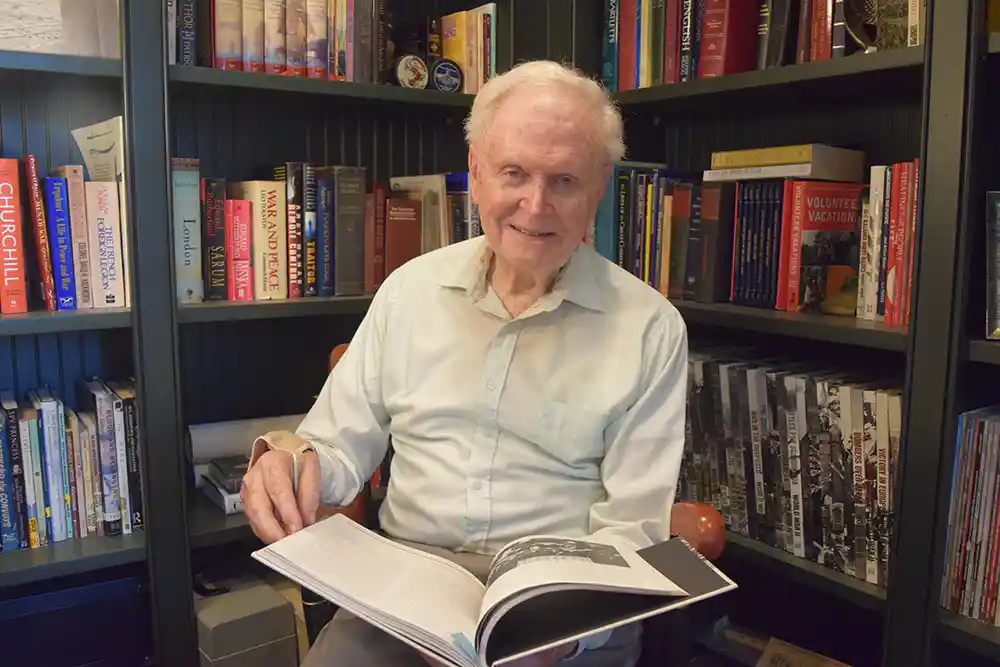
Roy Williams III was an icon on Sullivan’s Island. He knew the island frontwards and backwards, inside and out, top to bottom.
Not only had Williams lived on the island longer than just about any other resident, but he also wrote extensively on its history and architecture. He was even known to offer occasional tours of the island by trolley. When the island’s historical society, the Battery Gadsden Cultural Center, produced a video called “Architectural Gems of Sullivan’s Island,” Williams was tapped, of course, to be the narrator. He was a gem in his own right.
“Everybody loved Roy,” friend and island resident Hal Coste said. “He always had a smile. And he had a big heart.”
Williams died on March 11, 2023, at the age of 87.
The roots of Williams’ family run deep on the island, where his predecessors began summering in the 1800s. His grandfather purchased a house on the front beach at Station 9 in 1915 where Williams spent much of his youth, witnessing firsthand many facets of life on the island that have now disappeared. Like when the Pitt Street Bridge was the only path for newfangled automobiles to take from Mount Pleasant to Fort Moultrie, and island houses were likely cottages lacking hot water, heat or air conditioning. Or when full-time residents lived on the back beach and summer homes were on the front beach, and small family-owned groceries were scattered throughout the island and made deliveries to the locals. And when there was a movie theater at Fort Moultrie or when Battery Marshall near Breach Inlet housed Italian prisoners of war during World War II. The list goes on and on.
Williams lived on the island for over seven decades. He attended Sullivan’s Island Elementary School and was a 1953 graduate of Moultrie High School. As an undergraduate at the University of South Carolina, he studied journalism and edited the student newspaper, The Daily Gamecock.
After college, Williams received a commission as an officer in the U.S. Navy and met his wife of 58 years while stationed on the West Coast. But being a Charlestonian, he brought his bride home upon his discharge and landed a job writing for the Charleston News and Courier. Later, after earning a master’s degree in history at USC, he taught at Wando High School for nearly two decades.
In retirement, Williams served as president of the St. James Santee Parish Historical Society and was a docent at Hampton Plantation. He authored several books: one on St. James Parish, another a pictorial illustrating Sullivan’s Island’s architecture, and a third, “Rice to Ruin,” chronicling the rise and fall of the Lowcountry’s biggest plantation crop. Williams was also a primary source for many articles that have appeared through the years in local publications, including this one. In 2005, the South Carolina General Assembly honored Williams for devoting his life to teaching as well as to researching and preserving the historical, cultural and environmental character of the East Cooper area.
Sullivan’s Island resident Mike Walsh, president of Battery Gadsden Cultural Center, recalled that on the trolley tours, “someone would have to tug on Roy’s pants leg to encourage him to move on to the next house on the tour, since he could’ve talked for hours about each and every house on the island.”
His brother, Dr. Michael Williams, confirmed that his sibling “loved the island and the people.” He remembered, too, that “even in grammar and high school, Roy was very studious and was the head of his class. He was always interested in things that older people were interested in. And he was also somewhat of an artist. When we were children, our neighborhood had a small newspaper and Roy would draw pictures to accompany the articles in it. He was a wonderful person and lived a wonderful life.”
Soft-spoken and deliberate, mannerly and easy-going, Williams never met a stranger. If you ever had the good fortune to meet him, he undoubtedly gave you a tidbit of history you would have never known otherwise. But in case you never had such luck, a recorded interview with Williams is archived as part of the College of Charleston’s oral history project and can be viewed online at the Lowcountry Digital Library.
Fortunately for us all, a little bit of Williams’ vast knowledge is forever captured in print and video.
By Mary Coy

I think that the theatre was next to Town Hall…I remember it being there in the 50’s…